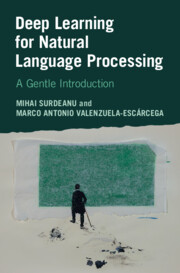Book contents
- Frontmatter
- Contents
- List of Figures
- List of Tables
- Preface
- 1 Introduction
- 2 The Perceptron
- 3 Logistic Regression
- 4 Implementing Text Classification Using Perceptron and Logistic Regression
- 5 Feed-Forward Neural Networks
- 6 Best Practices in Deep Learning
- 7 Implementing Text Classification with Feed-Forward Networks
- 8 Distributional Hypothesis and Representation Learning
- 9 Implementing Text Classification Using Word Embeddings
- 10 Recurrent Neural Networks
- 11 Implementing Part-of-Speech Tagging Using Recurrent Neural Networks
- 12 Contextualized Embeddings and Transformer Networks
- 13 Using Transformers with the Hugging Face Library
- 14 Encoder-Decoder Methods
- 15 Implementing Encoder-Decoder Methods
- 16 Neural Architectures for Natural Language Processing Applications
- Appendix A Overview of the Python Language and Key Libraries
- Appendix B Character Encodings: ASCII and Unicode
- References
- Index
14 - Encoder-Decoder Methods
Published online by Cambridge University Press: 01 February 2024
- Frontmatter
- Contents
- List of Figures
- List of Tables
- Preface
- 1 Introduction
- 2 The Perceptron
- 3 Logistic Regression
- 4 Implementing Text Classification Using Perceptron and Logistic Regression
- 5 Feed-Forward Neural Networks
- 6 Best Practices in Deep Learning
- 7 Implementing Text Classification with Feed-Forward Networks
- 8 Distributional Hypothesis and Representation Learning
- 9 Implementing Text Classification Using Word Embeddings
- 10 Recurrent Neural Networks
- 11 Implementing Part-of-Speech Tagging Using Recurrent Neural Networks
- 12 Contextualized Embeddings and Transformer Networks
- 13 Using Transformers with the Hugging Face Library
- 14 Encoder-Decoder Methods
- 15 Implementing Encoder-Decoder Methods
- 16 Neural Architectures for Natural Language Processing Applications
- Appendix A Overview of the Python Language and Key Libraries
- Appendix B Character Encodings: ASCII and Unicode
- References
- Index
Summary
In Chapters 10 and 12, we focused on two common usages of recurrent neural networks and transformer networks: acceptors and transducers. In this chapter, we discuss a third architecture for both recurrent neural networks and transformer networks: encoder-decoder methods. We introduce three encoder-decoder architectures, which enable important NLP applications such as machine translation. In particular, we discuss the sequence-to-sequence method of Sutskever et al. (2014), which couples an encoder long short-term memory with a decoder long short-term memory. We follow this method with the approach of Bahdanau et al. (2015), which extends the previous decoder with an attention component, which produces a different encoding of the source text for each decoded word. Last, we introduce the complete encoder-decoder transformer network, which relies on three attention mechanisms: one within the encoder (which we discussed in Chapter 12), a similar one that operates over decoded words, and, importantly, an attention component that connects the input words with the decoded ones.
Information
- Type
- Chapter
- Information
- Deep Learning for Natural Language ProcessingA Gentle Introduction, pp. 216 - 228Publisher: Cambridge University PressPrint publication year: 2024
